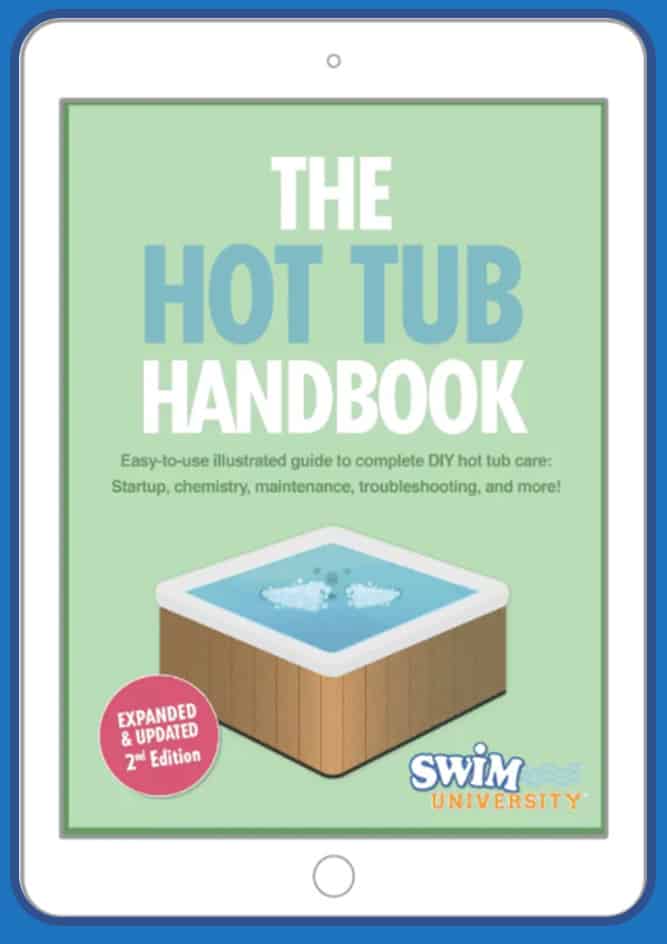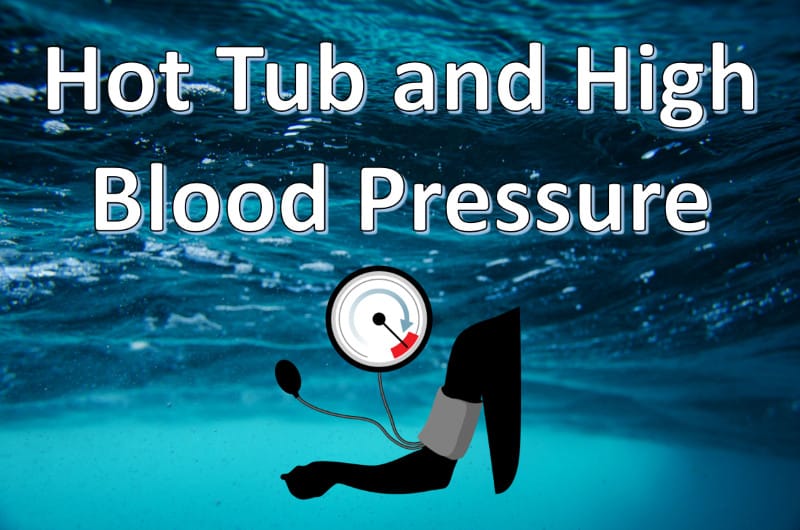Is a hot tub and high blood pressure bad for me?
Someone with high blood pressure can significantly improve their health using a hot tub. Hot tubs offer water therapy, improve circulation, relieve pain and inflammation, help heal old injuries, and allows people to relax, ultimately lowering blood pressure. Using the spa 10 to 15 minutes a day will allow someone to enjoy these improvements in health. Always check with your doctor to make sure it’s safe to use a hot tub.
Stop wasting time and money with hot tub maintenance and confusing water chemistry! The Hot Tub Handbook and Video Course will help keep your hot tub balanced, sanitized, and crystal clear all the time.
Check out my list of high-quality hot tub products to help keep your hot tub clean and running great all year long!
If you’re looking for a high-quality blood pressure monitor, I recommend the Lazle Blood Pressure Monitor.
I have family members who have high blood pressure, and I’m sometimes asked if it’s ok to use a hot tub when dealing with this important health issue.
I studied the topic and this is what I found.
High blood pressure is the precursor to many comorbidities, including heart disease, increased risk of stroke, and aneurysms. Of course, your doctor can prescribe you a medication along with a traditional diet and exercise, but if you’re looking for a great way to supplement your wellness, try this.
The soothing warmth and deep pressure stimulation of hot tubs can help lower your hypertension, thereby decreasing your heart attack or stroke risk. Along with medicine and a healthy diet/exercise regime, a hot tub can help you take charge of your health and bring those numbers down!
What Causes High Blood Pressure?
High blood pressure can stem from many factors, one of them being genetic. If your parents or other family members have a history of high blood pressure, chances are you will have it as well. However, high blood pressure is also attributed to dietary factors, like too much salt or insulin production. These things raise cholesterol levels and can cause the heart to accumulate plaque and inflammation. If left untreated, high blood pressure can strain the heart and lead to heart disease, and in some cases, cardiac arrest. Studies have also shown that high blood pressure can increase your chances of having a stroke.
Why is High Blood Pressure Bad for You?
High blood pressure signifies that your body (and, more importantly, your heart) has to work harder to oxygenate your muscles. It’s not uncommon to see Olympic athletes with shallow blood pressures and heart rates, as their physical fitness and low sodium/sugar diet make it easier for the heart to do its job. However, not everyone is an Olympic athlete, and for many people, diet and exercise alone aren’t enough to maintain high blood pressure levels. It’s always important to seek the help of a doctor or medical professional to determine what treatment plan is best for you.
Suppose you’re looking for a natural way to help your body curb high blood pressure levels in addition to your medical regime. In that case, you might consider checking out the benefits of a hot tub.
Another great way to monitor your health is the Withings Body+ Smart Scale which will monitor your body weight, body fat, BMI, water percentage, muscle, bone mass, and pregnancy tracker.

Stop wasting time and money with hot tub maintenance and confusing water chemistry! Get Instant access to this easy-to-use book and video course so you can spend less time cleaning and more time soaking.
Learn MoreThe Link Between Anxiety and Blood Pressure
There are, of course, people with healthy BMIs and great exercise routines that still experience hypertension. However, high blood pressure doesn’t always necessarily stem from dietary issues. Instead, it’s often the result of anxiety. If you have Generalized Anxiety disorder (GAD), Panic disorder (PD), or another mental health issue, you might be experiencing high blood pressure as a symptom of those disorders. Panic attacks (and anxiety attacks) can cause genuine physical symptoms, such as increased heart rate. This leads to elevated blood pressure levels, which can further make a person feel unsettled.
The Effect of Stress and High Blood Pressure
Stress is another significant factor in developing long-term high blood pressure. Stress is nothing to brush off or accept as a normal part of life. It can have real ramifications on your central nervous system, among other things. Significant, sustained stress has been shown to cause heart damage, inflammation in the heart and eventually lead to significant events, such as a stroke. One of the determining factors in whether or not a patient is having a stroke is whether their blood pressure is exceptionally high. This because some strokes are caused by skyrocketing blood pressure that damages the blood vessels, causing the blood supply to your brain to be cut off.

Staying Heart Healthy
It’s normal for your blood pressure to vary during the day. Like our heart rate, our blood increases or decreases its pressure to keep up with our aerobic and anaerobic demands. However, consistently high blood pressure readings could indicate that a more significant problem is at hand. You may not feel the effects of high blood pressure right away, but inside, it is causing considerable stress to the veins, arteries, and chambers of the heart. This inflammation and damage cause these channels to weaken over time and become narrow. A narrow blood vessel is more likely to be stopped up with cholesterol or plaque, causing a blockage. This blockage can lead to an aneurysm, stroke, or heart attack.
How a Hot Tub Can Help Lower Blood Pressure
Most people with high blood pressure experience some challenges with their weight or lifestyle. Anyone who has been told to lose weight knows that it’s not that easy! Older people, who are statistically more likely to suffer from hypertension, may also have joint pain or limited mobility that impacts their ability to exercise. Medication or lifestyle changes might not be enough for you to keep your blood pressure under control. If you suffer from joint pain or arthritis, a hot tub can do wonders for you. As we’ll discuss, hot tubs can help lower your blood pressure and improve your circulation. However, it’s also fantastic for loosening those tight muscles and taking the weight off your joints.
If you’re looking for a less expensive option for buying a hot tub, check out our full review on inflatable hot tubs, and if they’re worth buying.
How a Hot Tub Can Help
The saying goes that I are what I eat. But it’s a little known that we’re also what I exercise and how I treat our bodies. So if high-stakes cardio sounds damaging for your body, chances are it is! Consider this: the continuously flowing, bubbling jets of a hot tub. The weightlessness of the water. The warmth that envelopes you and soothes your muscles. Your skin, your body’s natural barrier, rejuvenated by fresh, flowing waters. What happens to our body on the outside, I internalize. It’s no wonder, then, that hot tubs help improve your circulation, joint pain, and inflammation.
If you’re looking for a great spa robe as a gift I recommend this robe from Turquaz Linen.
If you’re looking for some great slippers to wear out to your spa, check out these memory foam slippers.
Water Therapy
It’s easy to imagine that a spa can reduce factors of high blood pressure like stress. But let’s dig into some of the scientific data on how hot tubs (and water therapy in general) can help rejuvenate the body and bring it to a state of equilibrium.
Dr. William Kormos of Harvard Health notes that sitting in a hot tub increases the heart rate and body’s core temperature, yet lowers the blood pressure (Harvard Men’s Health Watch). In some cases, it can lower your blood pressure too much, something essential to take note of if you have an existing heart condition. Otherwise, a ten-minute soak in the hot tub has excellent benefits for those with mild cases of hypertension.
Reversing the Damage
I mentioned earlier how high blood pressure could cause the arteries and blood vessels to narrow over time. As the folks over at Polyphenolics point out, the heat and circulation from a hot tub help widen and relax the blood vessels (Cardio Health). They also offer the warning that if you’re currently experiencing a hypertensive crisis (where your blood pressure is abnormally high and demands immediate medical attention), spending some time in the hot tub can have the opposite effect than what you want. It’s best to check with your doctor beforehand whether or not using the spa is suitable for you. If you spend some time in the hot tub, be sure to limit it to ten minutes.
Improving Circulation
In addition to greatly helping the circulatory system, it turns out that hot tubs can help with your lymphatic and musculoskeletal system as well.
Our lymphatic system consists of more than just lymph nodes. The lymph nodes are connected by an intricate pathway of veins and vessels designed to help move fluid through our body. This fluid can become trapped in parts of this network; significant accumulations of lymphatic fluid are known as lymphedema and are pretty common (and range in severity). The water circulation in a hot tub through bubblers and jets can help improve the body’s circulation and pressure on the heart. Just as manual massages are recommended for patients with lymphatic build-up, hot tub massages can be helpful as well.
Check out our full article on hot tubs helping you burn calories for more information on hot tub health benefits.

Helping Diabetics Heal
Are you a diabetic with high blood pressure? You understand more than anybody how something like hypertension can significantly affect your wellness. In addition, many people with diabetes suffer from poor circulation and tissue recovery.
There’s evidence to suggest that high blood sugar over time can lead to (you guessed it) narrow or damaged veins. So if you have diabetes and suffer from hypertension, you have quite a lot stacked against you! That’s why it’s essential to incorporate holistic and self-care practices alongside your medical regime as recommended by your doctor.
You might consider adding hydrotherapy as part of your routine, as the waters will stimulate your muscles and help circulate fluid within. Not only that, but it will help lower your blood pressure as well. Always check with your doctor before trying anything new.
Healing Inflammation
Contrary to popular belief, inflammation is a sign that your body is doing what it’s supposed to do: protect you and heal wounds. Inflammation occurs when the immune system sends white blood cells to an area damaged or has an infection.
But inflammation usually occurs in the form of redness, tenderness, soreness, stiffness, and ache. People with arthritis often experience daily bouts of inflammation, especially in the joints. The heat from a hot tub can help relax these areas and massage the muscle. Heat, whether through a heating pad, patch, or hot shower, is tremendous for reducing inflammation.
Hot or Cold?
Sure, hot tubs are called hot for a reason, but have you ever considered taking a plunge in a cold tub? There are just as many if not more health benefits to cold water immersion as there are hot.
By cold, I mean something slightly brisk and refreshing, perhaps even room temperature (which still feels pleasantly chilled to the body as it’s below our core temperature). Advanced hot tub models offer computer-based temperature controls, and yes, you can opt not to heat the water at all!
Instead, consider hopping in the tub before it’s warmed up to enjoy the cool water, then turn it on to heat. This alternation of heat and cold is fantastic for targeting pain and muscle aches. Don’t spend too long, however, and don’t repeatedly switch between the two. Coldwater can raise your blood pressure, so it’s best not to subject your body to any turbulent changes.
Check out our full article on using a hot tub in the winter for more information about water temperature.

Muscle Pains and Aches
Could high blood pressure be causing your muscle pain? If you have a consistently sore back, legs, or hips, then it just might be the reason why. I know that blood pressure restricts the blood vessels. These vessels are located throughout our muscles to keep them oxygenated and working. When these vessels are narrowed, it starves these muscles of oxygen, leading you to feel tired more easily and fatigued. Restricted blood vessels in your muscles can lead to aches and pain. It can also cause pain in your joints. Light exercise, such as yoga, has been shown to help “loosen” these muscles and dilate the blood vessels. Hot water, as we’ve discussed previously, has the same effect!
If you’re experiencing discomfort or a rash after using your hot tub, check out our full article on hot tub folliculitis rash.
Deep Pressure Stimulation
Have you heard of deep pressure stimulation? It’s a form of therapy that engages the nervous system through touch and gentle pressure. It’s also the science behind the weighted blanket fad. Deep pressure, such as a massage, acupuncture, or even a tight squeeze from a friend, releases hormones responsible for happiness and tranquility. If your high blood pressure results from ongoing stress or anxiety in your life, deep pressure stimulation might be the most beneficial aspect of a hot tub for you. The kneading of the jets reroutes this excess energy in the nervous system and helps your mind release dopamine, serotonin, and other hormones critical for mental wellness.
Does Insurance Cover Hot Tubs?
The answer is yes. As surprising as it may seem, many insurance companies add hot tubs, saunas, and other amenities to their policies. That’s not to say you can snap your fingers and make a hot tub appear for free, of course. Your doctor will have to prescribe hydrotherapy as a part of your treatment plan, and you’ll need to submit this alongside significant documentation for your claim to be approved. It turns out that many people, including some cancer patients and those with chronic illness, were able to get a decent hot tub covered by their insurance plans!
Floating Therapy
Floating therapy is a long-used practice making a resurgence in recent years. Typically, people partaking in float therapy will immerse themselves in a large pool where the water has high salinity. This high salinity contributes to the buoyancy and weightlessness in the water. Some hot tubs are even soundproof and lightproof to deprive you of your senses!
While you can try this out for yourself at a float therapy clinic near you, consider turning off the jets in your hot tub and letting yourself float. Why? The weightlessness and calm of the water can help your nervous system wind down and deactivate that “fight or flight” sense that contributes to anxiety and high blood pressure.
Check out our article on hot tub aromatherapy and how it can add a lot more comfort.
Hot Tubs and High Blood Pressure: Many Options
A hot tub or home spa is more than just a luxurious amenity. It can be a valuable tool for your health and wellness. It can even be used to do water aerobics, water walking, and more. Some hot tubs have a lounge seat with special jets and bubblers designed to target sore areas. With so many options on the market, you can find the right one for you and your health journey. If space is a concern (or if you rent), try browsing some of the inflatable hot tub selections. They’re easy to set up and put away and hold up well to wear and tear.
Hot Tub and High Blood Pressure: Conclusion

The correlation between a hot tub and high blood pressure is quite involved. On the one hand, it can cause distress for those who have severe heart conditions. On the other, research shows that it can significantly benefit those with milder symptoms of high blood pressure. You should always consult with your doctor before trying something new. You should also limit the amount of time you spend in the hot tub to under ten minutes and never exceed great temperatures. Whether the effects are mental or physical, hot tubs can have a significant improvement on your wellbeing and long-term health.
I hope you found this article on Hot Tubs and High Blood Pressure helpful.
Thanks for visiting spatoolkit.com
James Brockbank

Stop wasting time and money with hot tub maintenance and confusing water chemistry! Get Instant access to this easy-to-use book and video course so you can spend less time cleaning and more time soaking.
Learn More



